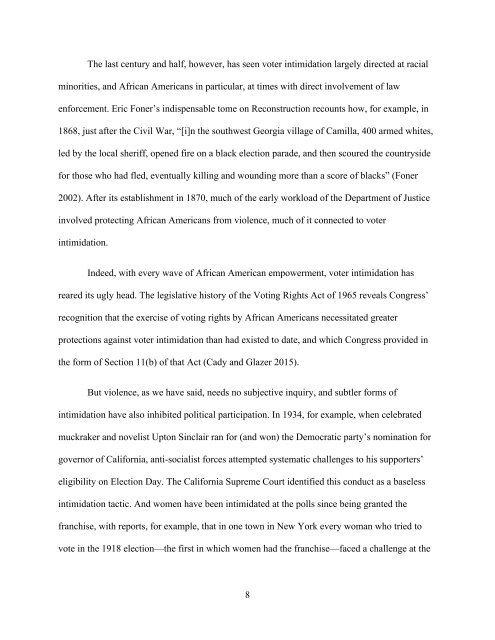Gitlin-Adam
Gitlin-Adam
Gitlin-Adam
You also want an ePaper? Increase the reach of your titles
YUMPU automatically turns print PDFs into web optimized ePapers that Google loves.
The last century and half, however, has seen voter intimidation largely directed at racial<br />
minorities, and African Americans in particular, at times with direct involvement of law<br />
enforcement. Eric Foner’s indispensable tome on Reconstruction recounts how, for example, in<br />
1868, just after the Civil War, “[i]n the southwest Georgia village of Camilla, 400 armed whites,<br />
led by the local sheriff, opened fire on a black election parade, and then scoured the countryside<br />
for those who had fled, eventually killing and wounding more than a score of blacks” (Foner<br />
2002). After its establishment in 1870, much of the early workload of the Department of Justice<br />
involved protecting African Americans from violence, much of it connected to voter<br />
intimidation.<br />
Indeed, with every wave of African American empowerment, voter intimidation has<br />
reared its ugly head. The legislative history of the Voting Rights Act of 1965 reveals Congress’<br />
recognition that the exercise of voting rights by African Americans necessitated greater<br />
protections against voter intimidation than had existed to date, and which Congress provided in<br />
the form of Section 11(b) of that Act (Cady and Glazer 2015).<br />
But violence, as we have said, needs no subjective inquiry, and subtler forms of<br />
intimidation have also inhibited political participation. In 1934, for example, when celebrated<br />
muckraker and novelist Upton Sinclair ran for (and won) the Democratic party’s nomination for<br />
governor of California, anti-socialist forces attempted systematic challenges to his supporters’<br />
eligibility on Election Day. The California Supreme Court identified this conduct as a baseless<br />
intimidation tactic. And women have been intimidated at the polls since being granted the<br />
franchise, with reports, for example, that in one town in New York every woman who tried to<br />
vote in the 1918 election—the first in which women had the franchise—faced a challenge at the<br />
8


